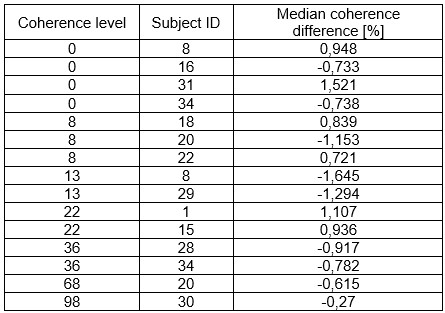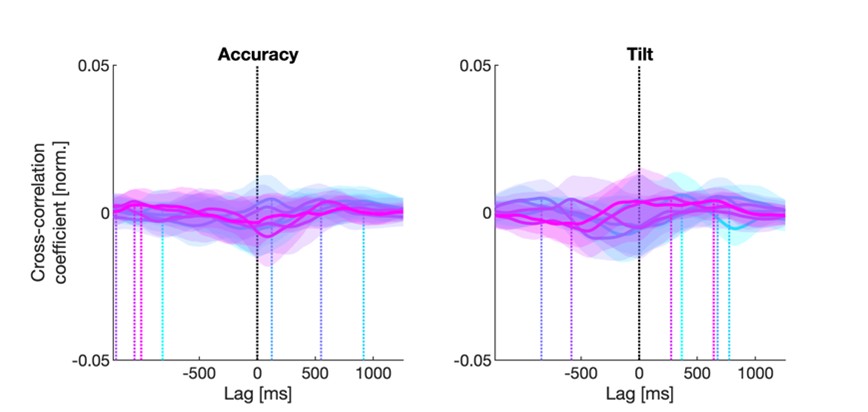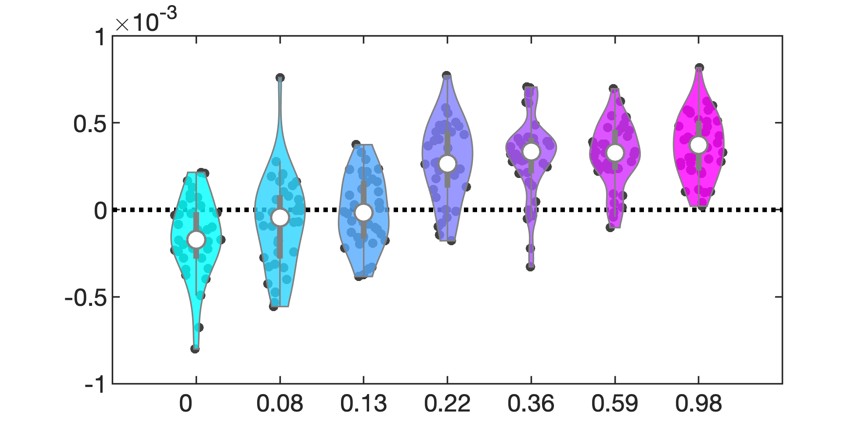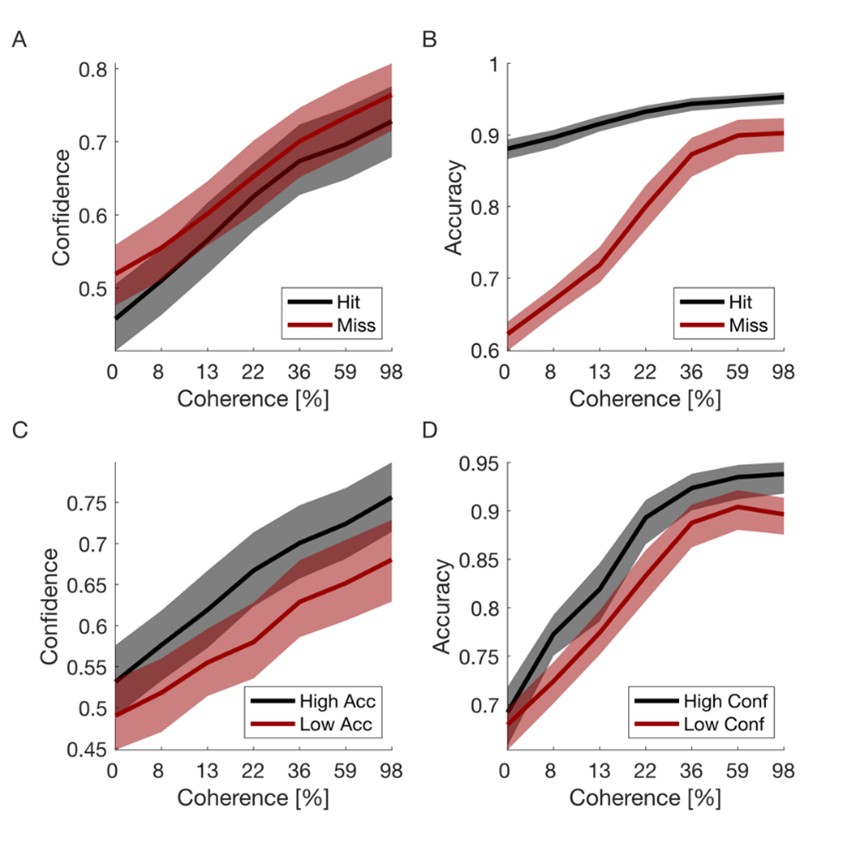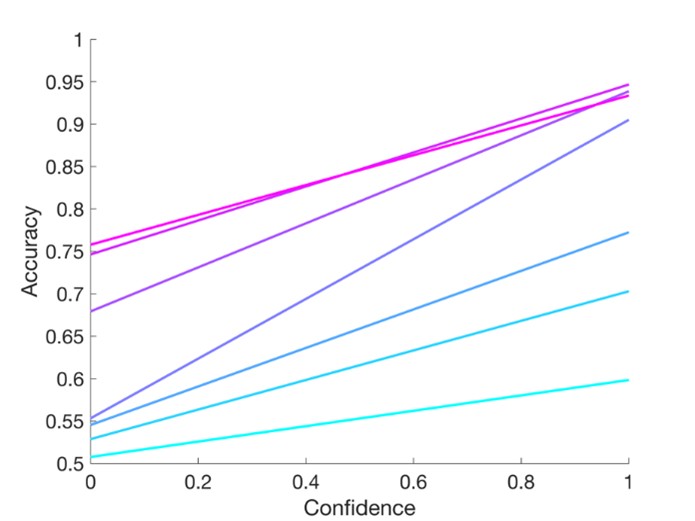Peer review process
Revised: This Reviewed Preprint has been revised by the authors in response to the previous round of peer review; the eLife assessment and the public reviews have been updated where necessary by the editors and peer reviewers.
Read more about eLife’s peer review process.Editors
- Reviewing EditorNils KollingStem-cell and Brain Institute (SBRI), U1208 Inserm, Bron Cedex, France
- Senior EditorJoshua GoldUniversity of Pennsylvania, Philadelphia, United States of America
Reviewer #1 (Public review):
Summary:
This paper reports an interesting and clever task which allows the joint measurement of both perceptual judgments and confidence (or subjective motion strength) in real / continuous time. The task is used together with a social condition to identify the (incidental, task-irrelevant) impact of another player on decision-making and confidence. The paper is well-written and clear.
Strengths:
The innovation on the task alone is likely to be impactful for the field, extending recent continuous report (CPR) tasks to examine other aspects of perceptual decision-making and allowing more naturalistic readouts. One interesting and novel finding is the observation of dyadic convergence of confidence estimates even when the partner is incidental to the task performance, and that dyads tend to be more risk-seeking (indicating greater confidence) than when playing solo.
One concern with the novel task is whether confidence is disambiguated from a tracking of stimulus strength or coherence. The subjects' task is to track motion direction and use the eccentricity of the joystick to control the arc of a catcher - thus implementing a real-time sensitivity to risk (peri-decision wagering). The variable-width catcher has been used to good effect in other confidence/uncertainty tasks involving learning of the spread of targets (the Nassar papers). But in the context of an RDK task, one simple strategy here is to map eccentricity directly to (subjective) motion coherence - such that the joystick position at any moment in time is a vector with motion direction and strength. The revised version of the paper now includes a comprehensive analysis of the extent to which the metacognitive aspect of the task (the joystick eccentricity) tracks stimulus features such as motion coherence. The finding of a lagged relationship between task accuracy and eccentricity in conjunction with a relative lack of instantaneous relationships with coherence fluctuations, convincingly strengthens the inference that this component of the joystick response is metacognitive in nature, and dynamically tracking changes in performance. This importantly rebuts a more deflationary framing of the metacognitive judgment, in which what the subjects might be doing is tracking two features of the world - instantaneous motion strength and direction.
The claim that the novel task is tracking confidence is also supported by new analyses showing classic statistical features of explicit confidence judgments (scaling with aggregate accuracy, and tracking psychometric function slope) are obtained with the joystick eccentricity measure.
Reviewer #2 (Public review):
Summary:
Schneider et al examine perceptual decision-making in a continuous task setup when social information is also provided to another human (or algorithmic) partner. The authors track behaviour in a visual motion discrimination task and report accuracy, hit rate, wager, and reaction times, demonstrating that choice wager is affected by social information from the partner.
Strengths:
There are many things to like about this paper. The visual psychophysics has been undertaken with much expertise and care to detail. The reporting is meticulous and the coverage of the recent previous literature is reasonable. The research question is novel.
Comments on revisions:
The authors have addressed my suggestions adequately
Author response:
The following is the authors’ response to the original reviews
Reviewer 1:
Strengths:
The innovation on the task alone is likely to be impactful for the field, extending recent continuous report (CPR) tasks to examine other aspects of perceptual decision-making and allowing more naturalistic readouts. One interesting and novel finding is the observation of dyadic convergence of confidence estimates even when the partner is incidental to the task performance, and that dyads tend to be more risk-seeking (indicating greater confidence) than when playing solo. The paper is well-written and clear.”
We thank reviewer 1 for this encouraging evaluation. Below we address the identified weaknesses and recommendations.
(1) Do we measure metacognitive confidence?
One concern with the novel task is whether confidence is disambiguated from a tracking of stimulus strength or coherence. […] But in the context of an RDK task, one simple strategy here is to map eccentricity directly to (subjective) motion coherence - such that the joystick position at any moment in time is a vector with motion direction and strength. This would still be an interesting task - but could be solved without invoking metacognition or the need to estimate confidence in one's motion direction decision. […] what the subjects might be doing is tracking two features of the world - motion strength and direction. This possibility needs to be ruled out if the authors want to claim a mapping between eccentricity and decision confidence […].”
We thank reviewer 1 for pointing out that the joystick tilt responses of our subjects could potentially be driven by stimulus coherence instead of metacognitive decision confidence. Below, we present four arguments to address this point of concern:
(1.1) Similar physical coherence between high and low confidence states
Nominal motion coherence is a discrete value, but the random noisiness in the stimulus causes the actual frame-by-frame coherence to be distributed around this nominal value. Because of this, subjects might scale their joystick tilt report according to the coherence fluctuations around the nominal value. To check if this was the case, we use a median split to separate stimulus states into states with large versus small joystick tilt, individually for each nominal coherence. For each stimulus state, we extracted the actual instantaneous (frame-to-frame) motion coherence, which is based on the individual movements of dots in the stimulus patch between two frames, recorded in our data files.
First, we compared the motion coherence between stimulus states with large versus small joystick tilt. For each stimulus state, we calculated average instantaneous motion coherence, and analyzed the difference of the medians for the large versus small tilt distributions for each subject and each coherence level. The resulting histograms show the distribution of differences across all 38 subjects for each nominal coherence, and are, except for the coherence of 22%, not significantly different from zero across subjects (Author response image 1). For the 22% coherence condition, the difference amounts to 0.19% – a very small, non-perceptible difference. Thus, we do no find systematic differences between the average motion coherence in states with high versus low joystick tilt.
Author response image 1.
Histograms of within-subject difference between medians of average coherence distributions with large and small joystick tilt for all subjects. Coherence is color-coded (cyan – 0%, magenta – 98%). On top, the title of each panel illustrates the number of significant differences (Ranksum test in each subject) without correction for multiple comparisons (see Author response table 1 below). In the second row of the title, we show the result of the population t-test against zero. Only 22% coherence shows a significant bias. Positive values indicate higher average coherence for large joystick tilt.
Author response table 1.
List of all individual significantly different coherence distributions between high and low tilt states, without correction for multiple comparisons. Median differences do not show a consistent bias (i.e. positive values) that would indicate higher average coherence for the large tilts.
(1.2) Short-term stimulus fluctuations have no effect
[…] But to fully characterise the task behaviour it also seems important to ask how and whether fluctuations in motion energy (assuming that the RDK frames were recorded) during a steady state phase are affecting continuous reporting of direction and eccentricity, prior to asking how social information is incorporated into subjects' behaviour.
In addition to the analysis of stimulus coherence and tilt averaged across each stimulus state (1.1), we analyzed moment-to-moment relationship between instantaneous coherence and ongoing reports of accuracy and tilt. Below, we provide evidence that short-term fluctuations in the instantaneous coherence (i.e. the motion energy of the stimulus) do not result in correlated changes in joystick responses, neither for tilt nor accuracy. For each continuous stimulus state, we calculated cross-correlation functions between the instantaneous coherence, tilt and accuracy, and then averaged the cross-correlation across all states of the same nominal coherence, and then across subjects. The resulting average cross-correlation functions are essentially flat. This further supports our interpretation that the joystick reports do not reflect short-term fluctuations of motion energy.
Author response image 2.
Cross-correlation between the length of the resultant vector with joystick accuracy (left) and tilt (right). Coherence is color-coded. Shaded background illustrates 95% confidence intervals.
(1.3) Joystick tilt changes over time despite stable average stimulus coherence
If perceptual confidence is derived from evidence integration, we should see changes over time even when the stimulus is stable. Here, we have analyzed the average slope of the joystick tilt as a function of time within each stimulus state for each subject and each coherence, to verify if our participants tilted their joystick more with additional evidence. This is illustrated with a violin plot below (Author response image 3). The linear slopes of the joystick tilt progression over the course of stimulus states are different between coherence levels. High coherence causes more tilt over time, resulting in positive slopes for most subjects. In contrast, low/no coherence results mostly in flat or negative slopes. This tilt progression over time indicates that low coherence results in lower confidence, as subjects do not wager more with weak evidence. In contrast, high coherence causes subjects to exhibit more confidence, indicated by positive slope of the joystick tilt.
Author response image 3.
Violin plots showing the fitted slopes of the joystick tilt time course in the last 200 samples (1667 ms) leading up to a next stimulus direction (cf. Figure 2D). Positive values signify an increase in joystick tilt over time. Each dot shows the average slope for one subject. Coherence is color-coded. The dashed line at zero indicates unchanged joystick tilt over the analyzed time window.
(1.4) Cross-correlation between response accuracy and joystick tilt
Similar to 1.2 above, we have cross-correlated the frame-by-frame changes of joystick accuracy and tilt for each individual stimulus state and each subject. Across subjects, changes in tilt occur later than changes in accuracy, indicating that changes in the quality of the report are followed by changes in the size of the wager. Given that this process is not driven by short-term changes in the motion energy of the stimulus (see 1.2 above), we interpret this as additional evidence for a metacognitive assessment of the quality of the behavioral report (i.e. accuracy) reflected in the size of the wager (our measure for confidence). (See Figure 2E).
(2) Peri-decision wagering is different to post-decision wagering
[…] One route to doing this would be to ask whether the eccentricity reports show statistical signatures of confidence that have been established for more classical punctate tasks. Here a key move has been to identify qualitative patterns in the frame of reference of choice accuracy - with confidence scaling positively with stimulus strength for correct decisions, and negatively with stimulus strength for incorrect decisions (the so-called X-pattern, for instance Sanders et al. 2016 Neuron […].
We thank reviewer 1 for the constructive feedback. Our behavioral data do not show similar signatures to the previously reported post-decision confidence expression (Desender et al., 2021; Sanders et al., 2016). The previously described patterns show, first of all, that confidence for the incorrect type1 decisions diverges from the correct type1 decisions, declining with stimulus strength (e.g. coherence), as compared to increase for correct decisions. In our task, there is a graded accuracy and (putative) confidence expression, but there are no correct or incorrect decisions – instead, there are hits and misses of the reward targets presented at nominal directions. Instead of a decline for misses, we observe an equally positive scaling with coherence for the confidence, both for hits and misses (Author response image 4A). This is because in our peri-decision wagering task, the expression of confidence causally determines the binary hit or miss outcome. The outcome in our task is a function of the two-dimensional joystick response: higher tilt (confidence) requires a more accurate response to successfully hit a target. Thus, a subject can display a high (but not high enough) level of accuracy and confidence but still remain unsuccessful. If we instead median-split the confidence reports by high and low accuracy (Author response image 4C), we observe a slight separation, especially for higher coherences, but still no clear different in slopes.
We do observe the other two dynamic signatures of confidence (Desender et al., 2021): signature 2 – monotonically increasing accuracy as a function of confidence (Author response image 4), and signature 3 – steeper type 1 psychometric performance (accuracy) for high versus low confidence (Author response image 4D).
Author response image 4.
Confidence (i.e., joystick tilt, left column) and accuracy reports (right column) for different stimulus coherence, sorted by discrete outcome (hit versus miss, upper row) and the complementary joystick dimension (lower row, based on median split).
Author response image 5.
Accuracy reports correlate positively with confidence reports. For each stimulus state, we averaged the joystick response in the time window between 500 ms (60 samples) after a direction change until the first reward target appearance. If there was no target, we took all samples until the next RDP direction change into account. This corresponds to data snippets averaged in Figure 2D. Thus, for each stimulus state, we extracted a single value for joystick accuracy and for tilt (confidence). Subsequently, we fitted a linear regression to the accuracy-confidence scatter within each subject and within each coherence level. The plot above shows the average linear regression between accuracy and confidence across all subjects (i.e., the slopes and intercepts were averaged across n=38 subjects). Coherence is color-coded.
(3) Additional analyses regarding the continuous nature of our data
I was surprised not to see more analysis of the continuous report data as a function of (lagged) task variables. […]
Reviewer 1 requested more analyses regarding the continuous nature of our data. We agree that this is a useful addition to our paper, and thank reviewer 1 for this suggestion. To address this point, we revised main Figure 2 and provided additional panels. Panel D illustrates the continuous ramp-up of both accuracy and tilt (confidence) for high coherence levels, suggesting ongoing evidence integration and meta-cognitive assessment. Panel E shows the cross-correlation between frame-by-frame changes in accuracy and tilt (see 1.4 above). Here, we demonstrate that changes in the accuracy precede changes in joystick tilt, characterizing the continuous nature of the perceptual decision-making process.
(4) Explicit motivation regarding continuous social experiments
This paper is innovating on a lot of fronts at once - developing a new CPR task for metacognition, and asking exploratory questions about how a social setting influences performance on this novel task. However, the rationale for this combination was not made explicit. Is the social manipulation there to help validate the new task as a measure of confidence as dissociated from other perceptual variables? (see query 1 below). Or is the claim that the social influence can only be properly measured in the naturalistic CPR task, and not in a more established metacognition task?
Our rationale for the combination of real-time decision making and social settings was twofold:
i. Primates, including humans, are social species. Naturally, most behavior is centered around a social context and continuously unfolds in real-time. We wanted to showcase a paradigm in which distinct aspects of continuous perceptual decision-making could be assessed over time in individual and social environments.
ii. Human behavior is susceptible to what others think and do. We wanted to demonstrate that the sheer presence of a co-acting social partner affects continuous decision-making, and quantify the extent and direction of social modulation.
We agree that the motivation for combining the new task and this specific type of social co-action should be more clear. We have clarified this aspect in the Introduction, line 92-109. In brief, the continuous, free-flowing nature of the CPR task and real-time availability of social information made this design a very suitable paradigm for assessing unconstrained social influences. We see this study as the first step into disentangling the neural basis of social modulation in primates. See also the response to reviewer 2, point 2, below.
(5) Response to minor points
(5.1) Clarification on behavioral modulation patterns
Lines 295-298, isn't it guaranteed to observe these three behavioral patterns (both participants improving, both getting worse, only one improving while the other gets worse) even in random data?
The reviewer is correct. We now simply illustrate these possibilities in Figure 4B and how these patterns could lead to divergence or convergence between the participants (see also line 282). Unlike random data, our results predominantly demonstrate convergence.
(5.2) Clarification on AUC distributions
Lines 703-707, it wasn't clear what the AUC values referred to here (also in Figure 3) - what are the distributions that are being compared? I think part of the confusion here comes from AUC being mentioned earlier in the paper as a measure of metacognitive sensitivity (correct vs. incorrect trial distributions), whereas my impression here is that here AUC is being used to investigate differences in variables (e.g., confidence) between experimental conditions.
We apologize for the confusion. Indeed, the AUC analysis was used for the two purposes:
(i) To assess the metacognitive sensitivity (line 175, Supplementary Figure 2).
(ii) To assess the social modulation of accuracy and confidence (starting at line 232, Figures 3-6).
We now introduce the second AUC approach for assessing social modulation, and the underlying distributions of accuracy and confidence derived from each stimulus state, separately in each subject, in line 232.
(5.3) Clarification of potential ceiling effects
Could the findings of the worse solo player benefitting more than the better solo player (Figure 4c) be partly due to a compressive ceiling effect - e.g., there is less room to move up the psychometric function for the higher-scoring player?
We thank the reviewer for this insight. First, even better performing participants were not at ceiling most of the times, even at the highest coherence (cf. Figure 2 and Supplementary Figure 3C). To test for the potential ceiling effect in the better solo players, we correlated their social modulation (expressed as AUC as in Figure 4) to the solo performance. There was no significant negative correlation for the accuracy (p > 0.063), but there was a negative correlation for the confidence (r = - 0.39, p = 0.0058), indicating that indeed low performing “better players in a dyad” showed more positive social modulation. We note however that this correlation was driven mainly by few such initially low performing “better” players, who mostly belonged to the dyads where both participants improved in confidence (green dots, Figure 4B), and that even the highest solo average confidence was at ceiling (<0.95). To conclude, the asymmetric social modulation effect we observe is mainly due to the better players declining (orange and red dots, Figure 4B), rather than due to both players improving but the better player improving less (green dots, Figure 4B).
Reviewer 2:
Strengths:
There are many things to like about this paper. The visual psychophysics has been undertaken with much expertise and care to detail. The reporting is meticulous and the coverage of the recent previous literature is reasonable. The research question is novel.
We thank reviewer 2 for this positive evaluation. Below we address the identified weaknesses and recommendations.
(1) Streamlining the text to make the paper easier to read
The paper is difficult to read. It is very densely written, with little to distinguish between what is a key message and what is an auxiliary side note. The Figures are often packed with sometimes over 10 panels and very long captions that stick to the descriptive details but avoid clarity. There is much that could be shifted to supplementary material for the reader to get to the main points.
We thank reviewer 2 for the honest assessment that our article was difficult to read and understand, and for providing specific examples of confusion. We substantially improved the clarity:
We added a Glossary that defines key terms, including Accuracy and Hit rate.
We replaced the confusing term “eccentricity” with joystick “tilt”.
We simplified Figures 3 and 5, moving some panels into supplementary figures.
We substantially redesigned and simplified our main Figure 4, displaying the data in a more straightforward, less convoluted way, and removing several panels. This change was accompanied by corresponding changes in the text (section starting at line 277).
More generally, we shortened the Introduction, substantially revised the Results and the figure legends, and streamlined the Discussion.
(2) Dyadic co-action vs joint dyadic decision making
A third and very important one is what the word "dyadic" refers to in the paper. The subjects do not make any joint decisions. However, the authors calculate some "dyadic score" to measure if the group has been able to do better than individuals. So the word dyadic sometimes refers to some "nominal" group. In other places, dyadic refers to the social experimental condition. For example, we see in Figure 3c that AUC is compared for solo vs dyadic conditions. This is confusing.
[…] my key criticism is that the paper makes strong points about collective decision-making and compares its own findings with many papers in that field when, in fact, the experiments do not involve any collective decision-making. The subjects are not incentivized to do better as a group either. […]
The reviewer is correct to highlight these important aspects. We did, in fact, not investigate a situation where two players had to reach a joint decision with interdependent payoff and there was no incentive to collaborate or even incorporate the information provided by the other player. To make the meaning of “dyadic” in our context more explicit, we have clarified the nature of the co-action and independent payoff (e.g. lines 107, 211, 482, 755 - Glossary), and used the term “nominal combined score” (line 224) and “nominal “average accuracy” within a dyad” (line 439).
Concerning the key point about embedding our findings into the literature on collective decision-making, we would like to clarify our motivation. Outside of the recent study by Pescetelli and Yeung, 2022, we are not aware of any perceptual decision-making studies that investigated co-action without any explicit joint task. So naturally, we were stimulated by the literature on collective decisions, and felt it is appropriate to compare our findings to the principles derived from this exciting field. Besides developing continuous – in time and in “space” (direction) – peri-decision wagering CPR game, the social co-action context is the main novel contribution of our work. Although it is possible to formulate cooperative or competitive contexts for the CPR, we leveraged the free-flowing continuous nature of the task that makes it most readily amendable to study spontaneously emerging social information integration.
We now more explicitly emphasize that most prior work has been done using the joint decision tasks, in contrast to the co-action we study here, in Introduction and Discussion.
(3) Addition of relevant literature to Discussion
[…] To see why this matters, look at Lorenz et al PNAS (https://www.pnas.org/doi/10.1073/pnas.1008636108) and the subsequent commentary that followed it from Farrell (https://www.pnas.org/doi/full/10.1073/pnas.1109947108). The original paper argued that social influence caused herding which impaired the wisdom of crowds. Farrell's reanalysis of the paper's own data showed that social influence and herding benefited the individuals at the expense of the crowd demonstrating a form of tradeoff between individual and joint payoff. It is naive to think that by exposing the subjects to social information, we should, naturally, expect them to strive to achieve better performance as a group.
Another paper that is relevant to the relationship between the better and worse performing members of the dyad is Mahmoodi et al PNAS 2015 (https://www.pnas.org/doi/10.1073/pnas.1421692112). Here too the authors demonstrate that two people interacting with one another do not "bother" figuring out each others' competence and operate under "equality assumption". Thus, the lesser competent member turns out to be overconfident, and the more competent one is underconfident. The relevance of this paper is that it manages to explain patterns very similar to Schneider et al by making a much simpler "equality bias" assumption.
We thank reviewer 2 for pointing out these highly relevant references, which we have now integrated in the Discussion (lines 430 and 467). Regarding the debate of Lorenz et al and Farell, although it is about very different type of tasks – single-shot factual knowledge estimation, it is very illuminating for understanding the differing perspectives on individual vs group benefit. We fully agree that it is naïve to assume that during independent co-action in our highly demanding task participants would strive to achieve better performance as a group – if anything, we expected less normative and more informational, reliability-driven effects as a way to cope with task demands.
Mahmoodi et al. is a particularly pertinent and elegant study, and the equality bias they demonstrate may indeed underlie the effects we see. We admit that we did not know this paper at the time of our initial writing, but it is encouraging to see the convergence [pun intended] despite task and analysis differences. As highlighted above (2), our novel contributions remain that we observe mutual alignment, or convergence, in real-time without explicitly formulated collective decision task and associated social pressure, and that we separate asymmetric social effects on accuracy and confidence.
Other reviewer-independent changes:
Additional information: Angular error in Figure 2
In panel A of the main Figure 2, we have added the angular error of the solo reports (blue dashed line) to give readers an impression about the average deviation of subjects’ joystick direction from the nominal stimulus direction. We have pointed out that angular error is the basis for accuracy calculation.
Data alignment
In the previous version of the manuscript, we have presented data with different alignments: Accuracy values were aligned to the appearance of the first target in a stimulus state (target-alignment) to avoid the predictive influence of target location within the remaining stimulus state, while the joystick tilt was extracted at the end of each stimulus state (state-alignment) to allow subjects more time to make a deliberate, confidence-guided report (Methods). We realized that this is confusing as it compares the social modulation of the two response dimensions at different points in time. In the revision, we use state-aligned data in most figures and analyses and clearly indicate which alignment type has been used. We kept the target-alignment for the illustration of the angular error in the solo-behavior (Figure 2). Specifically, this has only changed the reporting on accuracy statistics. None of the results have changed fundamentally, but the social modulation on accuracy became even stronger in state-aligned data.
In summary, we hope that these revisions have resulted in an easier-to-understand and convincing article, with clear terminology and concise and important takeaway messages.
We thank both reviewers and the editors again for their time and effort, and look forward to the reevaluation of our work.
References
Desender K, Donner TH, Verguts T. 2021. Dynamic expressions of confidence within an evidence accumulation framework. Cognition 207:104522. doi:10.1016/j.cognition.2020.104522
Pescetelli N, Yeung N. 2022. Benefits of spontaneous confidence alignment between dyad members. Collective Intelligence 1. doi:10.1177/26339137221126915
Sanders JI, Hangya B, Kepecs A. 2016. Signatures of a Statistical Computation in the Human Sense of Confidence. Neuron 90:499–506. doi:10.1016/j.neuron.2016.03.025

